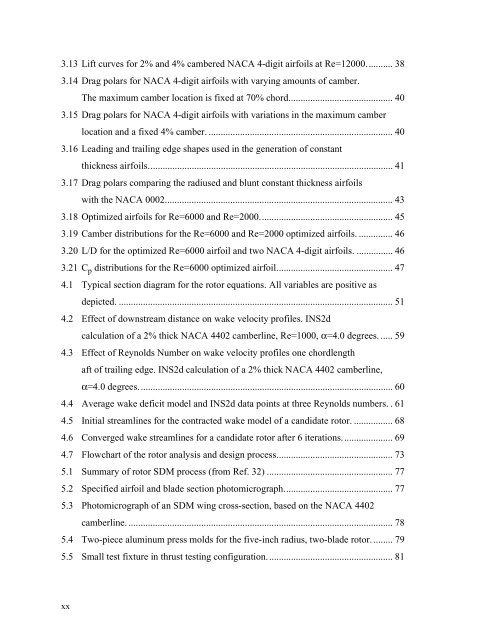Aerodynamics and Design for Ultra-Low Reynolds Number Flight
Aerodynamics and Design for Ultra-Low Reynolds Number Flight
Aerodynamics and Design for Ultra-Low Reynolds Number Flight
You also want an ePaper? Increase the reach of your titles
YUMPU automatically turns print PDFs into web optimized ePapers that Google loves.
3.13 Lift curves <strong>for</strong> 2% <strong>and</strong> 4% cambered NACA 4-digit airfoils at Re=12000........... 38<br />
3.14 Drag polars <strong>for</strong> NACA 4-digit airfoils with varying amounts of camber.<br />
xx<br />
The maximum camber location is fixed at 70% chord........................................... 40<br />
3.15 Drag polars <strong>for</strong> NACA 4-digit airfoils with variations in the maximum camber<br />
location <strong>and</strong> a fixed 4% camber. ............................................................................ 40<br />
3.16 Leading <strong>and</strong> trailing edge shapes used in the generation of constant<br />
thickness airfoils..................................................................................................... 41<br />
3.17 Drag polars comparing the radiused <strong>and</strong> blunt constant thickness airfoils<br />
with the NACA 0002.............................................................................................. 43<br />
3.18 Optimized airfoils <strong>for</strong> Re=6000 <strong>and</strong> Re=2000....................................................... 45<br />
3.19 Camber distributions <strong>for</strong> the Re=6000 <strong>and</strong> Re=2000 optimized airfoils. .............. 46<br />
3.20 L/D <strong>for</strong> the optimized Re=6000 airfoil <strong>and</strong> two NACA 4-digit airfoils. ............... 46<br />
3.21 C p distributions <strong>for</strong> the Re=6000 optimized airfoil................................................ 47<br />
4.1 Typical section diagram <strong>for</strong> the rotor equations. All variables are positive as<br />
depicted. ................................................................................................................. 51<br />
4.2 Effect of downstream distance on wake velocity profiles. INS2d<br />
calculation of a 2% thick NACA 4402 camberline, Re=1000, α=4.0 degrees. ..... 59<br />
4.3 Effect of <strong>Reynolds</strong> <strong>Number</strong> on wake velocity profiles one chordlength<br />
aft of trailing edge. INS2d calculation of a 2% thick NACA 4402 camberline,<br />
α=4.0 degrees......................................................................................................... 60<br />
4.4 Average wake deficit model <strong>and</strong> INS2d data points at three <strong>Reynolds</strong> numbers. . 61<br />
4.5 Initial streamlines <strong>for</strong> the contracted wake model of a c<strong>and</strong>idate rotor. ................ 68<br />
4.6 Converged wake streamlines <strong>for</strong> a c<strong>and</strong>idate rotor after 6 iterations..................... 69<br />
4.7 Flowchart of the rotor analysis <strong>and</strong> design process................................................ 73<br />
5.1 Summary of rotor SDM process (from Ref. 32) .................................................... 77<br />
5.2 Specified airfoil <strong>and</strong> blade section photomicrograph............................................. 77<br />
5.3 Photomicrograph of an SDM wing cross-section, based on the NACA 4402<br />
camberline. ............................................................................................................. 78<br />
5.4 Two-piece aluminum press molds <strong>for</strong> the five-inch radius, two-blade rotor. ........ 79<br />
5.5 Small test fixture in thrust testing configuration.................................................... 81




